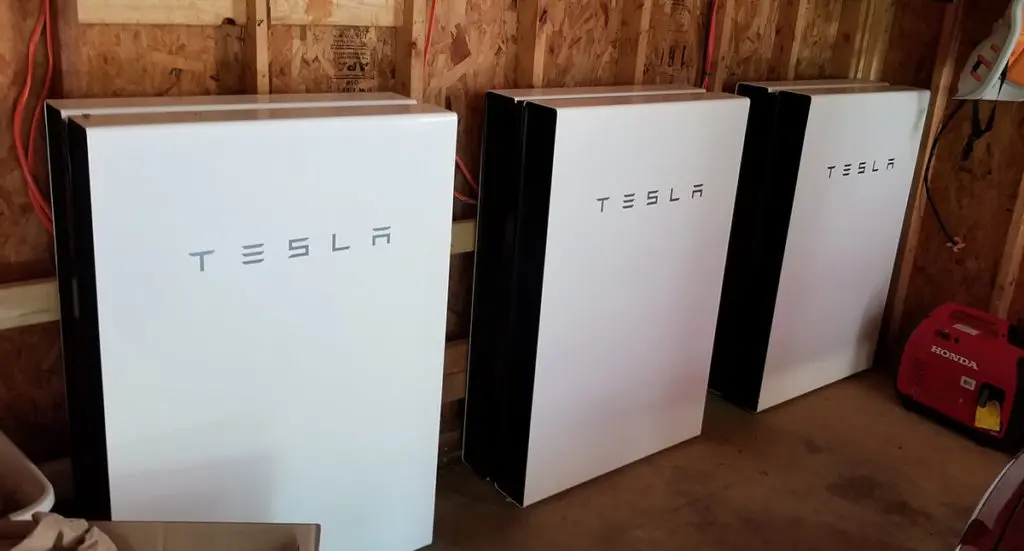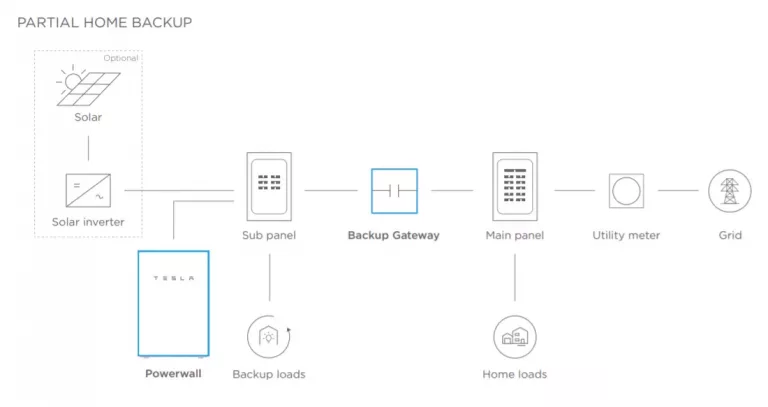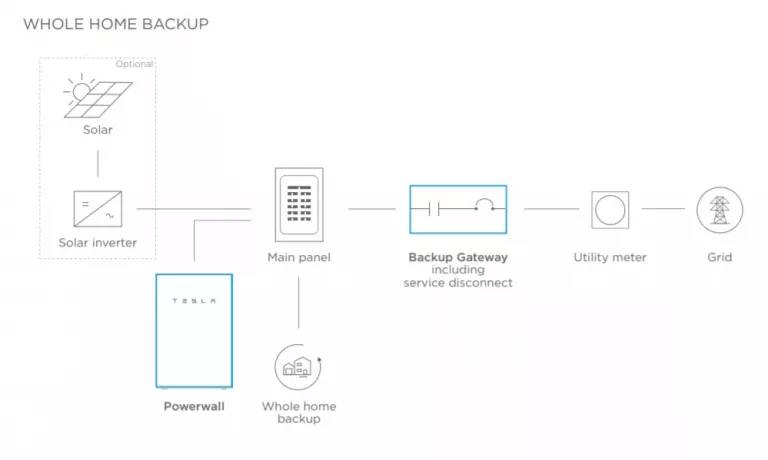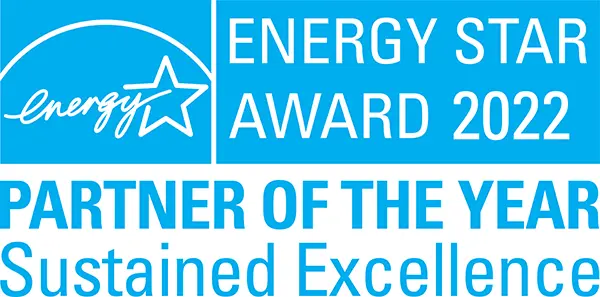- Alyssa Hardbower
- January 27, 2023
- 12 Minute Read
Topics in This Article
Is a Tesla Powerwall Worth It?
Whether you experience frequent grid outages, are looking for greater energy independence, or are hoping to maximize savings from your solar system, Tesla Powerwall can be a great solution to accomplish your energy goals.
As your local North Carolina based Certified Tesla Powerwall Installer, we can help to find a solution that’s right for you. But before we get started with customizing your battery + solar options, take a stroll through our 2023 Guide to Tesla Powerwall to answer your Tesla battery storage questions and to get a feel for whether the Powerwall might be the right product for you.
Top 17 Powerwall Questions Answered
What does a Tesla Powerwall battery do?
Just like any other battery storage option, a Tesla Powerwall captures and holds energy to be used by your home or business when needed later. What makes the Powerwall different from other battery storage options currently on the market is its capacity to support larger loads which means you have the freedom to power up more of what you need.
What are the benefits of a Powerwall?
A Tesla Powerwall can be used to increase self-consumption of solar production, save money with time-of-use load shifting, store and provide back-up power, and can help you to reach off-grid goals with the ease of customizing how your stored energy will be used right from the app.
Energy Security & Independence
Clean Power &
More Savings
Automated & Intuitive
App and Features
Tesla Powerwall 2 Technical Specs
Behind the Powerwall’s sleek, minimalist white casing is one of the highest density residential and light commercial AC battery storage solutions on the market. Backed by the Tesla name, the Powerwall 2 is a 13.5 kWh capacity rechargeable lithium-ion battery that boasts 7kW peak and 5kW continuous power. Each Powerwall holds 12.2 kWh of usable capacity and maintains a 10% reserve so that when the power goes out, the battery has enough power to turn your solar on to get the battery recharged when the sun comes up the next day. This is enough to run a few lights, keep your freezer from defrosting, and power a few select appliances; can you say Game of Thrones binge when the power is out?!
At roughly 45 inches tall, 30 inches wide, and 6 inches deep, the Powerwall 2’s compact profile combined with floor and wall mount options means you don’t have to sacrifice a ton of space for more storage. Check out the full product fact sheet to see all of the Tesla Powerwall 2’s Specs.
Are there Tesla Powerwall alternatives?
We recommend the Powerwall in most situations, but have also worked with LG Chem and Sonnen’s products. As a Certified Generac Dealer, we can also offer the PWRcell as a battery storage option. This is one of the newer products on the market and we’re excited for the future of battery storage and the potential for more options.

How It Works
- How does a Tesla Powerwall battery work?
- What can you power with a Tesla Powerwall?
- How long does a Powerwall battery last on one charge?
- How many Powerwalls do you need?
- Will Tesla Powerwall run an air conditioner?
- Where can a Tesla Powerwall be installed?
- Can you set Powerwall 2 charging priorities?
- Does the Powerwall automatically switch on when the grid fails?
- What is the Storm Watch function?
- Can you charge your vehicle during a power outage?
How does a Tesla Powerwall battery work?
In basic terms, sunlight is captured by your solar panels then converted into energy that you can use for your home. As that energy flows into your house, it is used by your appliances and any excess energy is stored in the Powerwall. Once the Powerwall is fully charged, additional electricity your system generates on top of that is sent back to the grid. When the sun goes down and your solar panels are not producing energy, your Powerwall will provide electricity to power your home.
What can you power with a Tesla Powerwall?
In very general terms, one Powerwall should be able to cover your emergency circuits, lights, and outlets. If you are looking to power larger appliances 2-3 Powerwalls is a good start. Ultimately, to determine what’s best for your home, we need to take a look at your average energy usage and discuss what you’re looking to get out of your battery storage system.
It’s all about the give and take when it comes to planning out your home battery storage solution. When designing your energy storage system, it is essential to find a balance between the total capacity of the Powerwall(s) with the demand of everything you need to power up.
Each Powerwall can deliver up to 21 amps, and up to 6 Powerwalls can be stacked together. However, even if there is enough amperage to cover all of your loads, we need to consider the pace of how quickly electricity will be drawn to maximize the effectiveness of your back-up system.
A common misconception is that your solar output will recharge your battery at the same rate you’re using it. This depends greatly on uncontrollable factors like weather and user consumption habits. An easy way to look at battery storage is to think of how driving tendencies vary by operator and by vehicle. You may be a more efficient driver of your new Prius while your cousin Karen drives a 2001 Jeep Wrangler like she’s running a desert race.
Similarly, Powerwall performance will be dependent on user consumption tendencies and what you are powering up. Efficiency is key. Stored energy will go further in powering a smaller, highly efficient home with energy efficient appliances versus a larger, older home with leaky windows and heirloom electronics. By monitoring your usage and storage abilities, you’ll gain greater insight into what you can power (and for how long) and how quickly your Powerwall might recharge in certain conditions.
How long does a Powerwall battery last on one charge?
It depends on what you use. Let’s just say you won’t be blasting your AC if the power goes off at night. A more realistic assumption for one Powerwall would be to run ten 100 watt light bulbs for 12 hours (without recharging the battery).
How many Powerwalls do you need?
We’re seriously not trying to dodge this question, but it really is different on a site-to-site basis and from a personal preference. 70% of our customers buy more than one Powerwall. For most systems, we install 2 or 3 Powerwalls. The total number is a personal choice depending on how much power you want or need to store and what types of devices you hope to switch on during a grid outage.
Each of our systems are fully customized to maximize the homeowner’s financial benefit and to reach their goals. To get a full picture of how many Powerwalls you might need, we would need to have an in-depth conversation about your objectives and review your average consumption history.
Will Tesla Powerwall run an air conditioner?
The simple answer is yes, a Tesla Powerwall can run an air conditioner! The more complex answer is, it depends on whether you have partial home or whole-home backup, and what circuits you choose to be backed up by your battery at the time of installation.
Partial Home Backup
One Tesla Powerwall is considered a partial home backup scenario, which means you’ll be able to backup low amperage circuits like your lights, wifi router, and refrigerator. Your air conditioner would be considered a high amperage load so you’ll need to look into a whole-home backup solution if you want the AC on when the power is out.
Whole Home backup
Whole-home backup can be achieved with TWO or more Tesla Powerwalls. This is where you’ll have more options for how much you can back up with your battery, such as an A/C system.
Where should you install a Tesla Powerwall?
We recommend installing the Powerwall in finished non-living spaces inside your home – like a garage, basement, or mechanical room – to protect the battery from the elements. A shed also makes a great option. Spaces like these are where you’ll see the highest efficiency to maximize your Powerwall’s benefit both when the grid is functioning normally and when the grid has failed.
If a finished non-living interior space isn’t possible, the Powerwall 2 is rated to be installed outside but may see reduced functionality in cold weather. Your solar designer can talk you through the details and options.
Can you set Powerwall 2 charging priorities?
There are various consumption modes which set priorities for charging and consuming that you can program your Powerwall to from the app.
- Backup Only -- All the energy in your Powerwall is saved for those rainy days when you need emergency back-up power
- Self Powered -- Power your home with energy stored from your solar system after the sun sets
- Balanced Time-Based Control -- Power your home when the sun goes down, and avoid expensive on-peak electricity rates by using electricity stored from your solar system
- Cost-Saving Time-Based Control -- Maximize your savings by using stored, low-cost, off-peak energy during expensive, on-peak hours
Does the Powerwall automatically switch on when the grid fails?
Your Powerwall will operate in a grid failure and your home will automatically switch over to the batteries.
If the sun is shining when the grid goes down, your solar system will continue to charge your batteries and stop sending any energy back to the grid. We are required by code to install a “gateway” unit that relays power from your system to the Powerwall and isolates all the power in the house from the grid. This ensures the safety of line workers and is an automatic process when the grid goes out.
What is the Storm Watch function?
When there is inclement weather in your area, the Powerwall automatically initiates the Storm Watch feature and charges the battery to its maximum capacity so it can be ready to back up your loads if the power goes out.
Can you charge your vehicle during a power outage?
During a power outage, the Powerwall can aid vehicle charging without sacrificing its capabilities or energy capacity. The battery will continuously balance your home’s energy needs with your vehicle charging demand during an outage to ensure you get power to your priority loads when you need them.
Do I have to install a Powerwall with a solar system?
Not technically, but it’s hard to see the benefit of having battery storage that’s not connected to a solar system in North Carolina. Unlike areas that have a high variation in on-peak and off-peak rates, think California, time-of-use load shifting isn’t as financially rewarding in the Tar Heel State.
If you live in Duke Energy territory, battery backup may also not be extremely advantageous since net metering allows you to store your excess production on the grid as a credit to use later. This is essentially a free energy storage vault.
However, for those who live in areas where their utility does not operate under net metering, a solar + battery storage system can be especially beneficial. Many municipal and co-op electric utilities have difficulty providing a good rate for electricity exported to the grid, decreasing the financial benefit of going solar.
The best solution is to include a battery backup with the solar PV system. This way, all excess electricity is stored in your home battery instead of being sold to the utility at a very low, wholesale rate. Each day after the sun goes down, your batteries provide electricity until they run out so you don’t have to draw expensive power from the grid.
This does add a premium to the price of the system since batteries are the most costly component. However, batteries (both standalone and connected to a solar system) are eligible for the 30% Federal Solar Investment Tax Credit.
Free Solar Power 101 Guide
How long does it take a Powerwall to charge with solar?
This is another question that’s hard to quantify. How long it takes to charge a Powerwall with solar really depends on factors like the weather, brightness, shading on your system, and outside temperature.
In general, in perfect conditions with no loads and 7.6kW of solar power, a Powerwall could charge in 2 hours.
How many solar panels do you need to charge a Powerwall?
Technically, you could charge a Powerwall with 1 solar panel or even install it without a solar system! But, in almost all cases in North Carolina we wouldn’t recommend that.
The average size solar system we sell with a Powerwall is a 6kw system, or about 20 solar panels. Again, this isn’t the perfect answer for everyone, or a one size fits all product.
We’ll determine how many solar panels and Powerwalls are right for your home based on your energy needs and goals for emergency power.
Can I use a Powerwall to go off-grid?
The short answer is potentially, but the big misunderstanding is what off-grid really means and how much it would cost.
In a true off-grid scenario, your home would not be connected to a utility company’s electric grid. In North Carolina, it can be difficult to elect to disconnect from the grid once the property is already connected. You can terminate your service, but you would need a large enough solar system and an extensive amount of batteries to maintain the average family’s lifestyle.
That size solar + battery set would come with a six figure price tag. Along with the cost, you need to consider what your alternative energy source would be if you are unable to recharge your batteries from solar.
Keep in mind, even if you are still connected to the grid, a solar + battery solution will significantly reduce your reliance on your utility (while also providing energy savings) without the added complication and cost of engineering a fully disconnected off-grid solution. At the end of the day, it’s possible to reach net-zero electricity use — or even be net-positive — without physically disconnecting from the grid, and it’s a lot easier on your wallet.
On the flip side, in a new construction scenario in an undeveloped area, going solar with battery backup can amount to huge savings compared to what it might cost to have the utility run power to the site…depending on its location. If you’re already off-grid, a Powerwall is also better solution than a lead-acid battery because of its capacity and longevity.
What is Powerwall+ and how is it different from Powerwall2?
Tesla’s Powerwall+ system is a Tesla inverter and a Tesla Powerwall essentially bundled together. This also allows the inverter to better communicate with the battery, while offering higher surge capacity during a power outage with added cost savings.
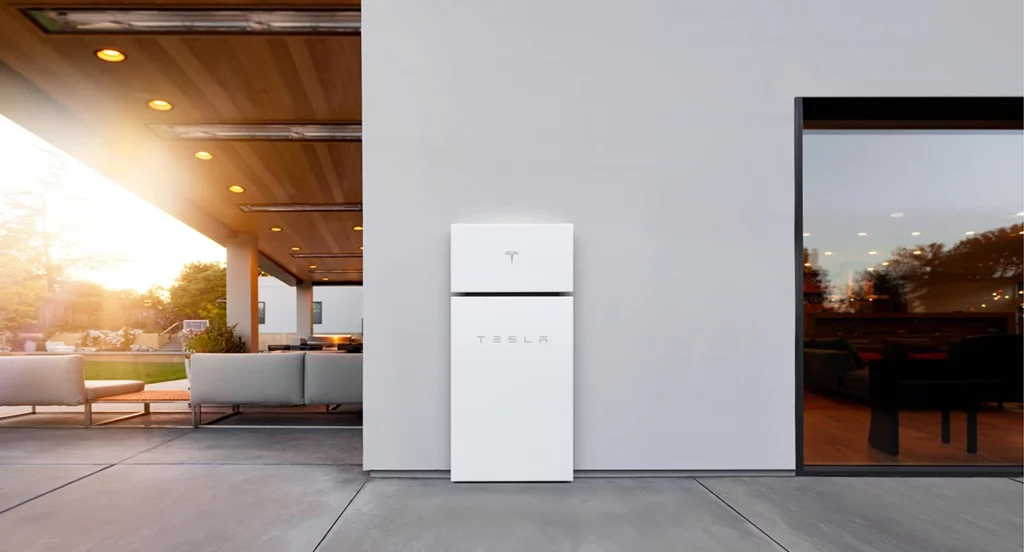
While that all sounds amazing, there is one major limitation to this product to be aware of. The Powerwall+ system performs best for non-shaded homes. We’re talking very limited to no shading, like new-construction-home-in-a-brand-new-development level of shading.
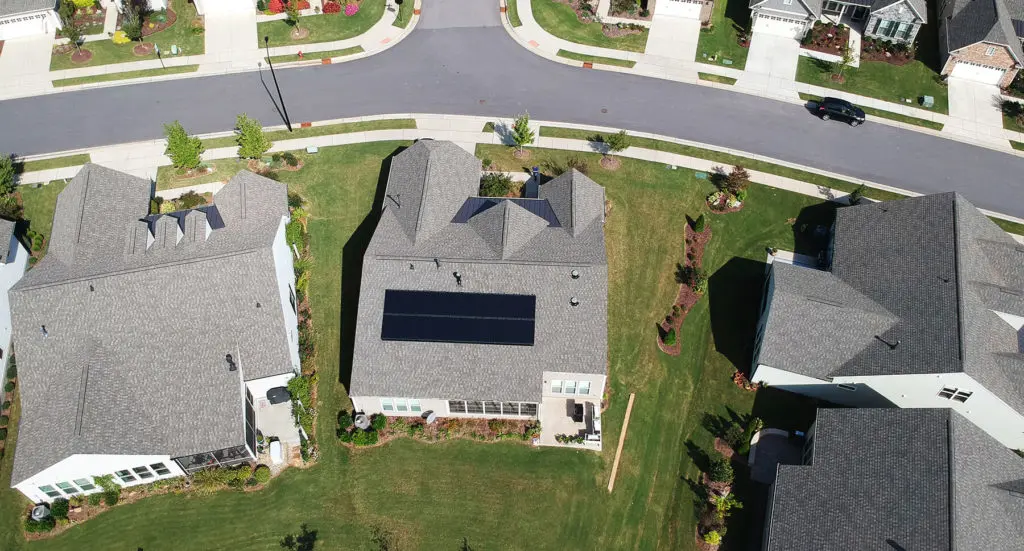
How much does a Tesla Powerwall cost?
A single Powerwall can run from $14,200 – $15,600 before tax credits are applied, with additional units coming in at $11,600 each.
Exciting news! The Federal Solar Investment Tax Credit (ITC) was recently expanded to 30% with the signing of the Inflation Reduction Act and now includes standalone batteries. Learn more about NC solar incentives here.
What is the wait time for a Tesla Powerwall?
We are a premier Certified Tesla Powerwall installer and have been installing Powerwalls with new solar systems and adding them to existing solar systems every day. If you’ve been following Tesla for awhile, you’ll know that their products are in high demand, which can result in delayed supply. If you’re interested in the Powerwall product, let us know so we can get you on the list!
It is important to remember that installation of a Powerwall requires design and permits so it does take a couple weeks at a minimum to get everything sorted. In most circumstances the Powerwall will be installed with your solar system, so we will schedule those installations to happen together.
If you’re anxiously preparing for winter storm or hurricane season in North Carolina, now is the time to reach out about getting your Powerwall project started before bad weather is in the forecast.
How long does installation take?
Unless there are unforeseen complications, installing a Powerwall takes about one day. In most cases, we’ll be installing the battery with your solar system which shouldn’t extend the installation time for you.
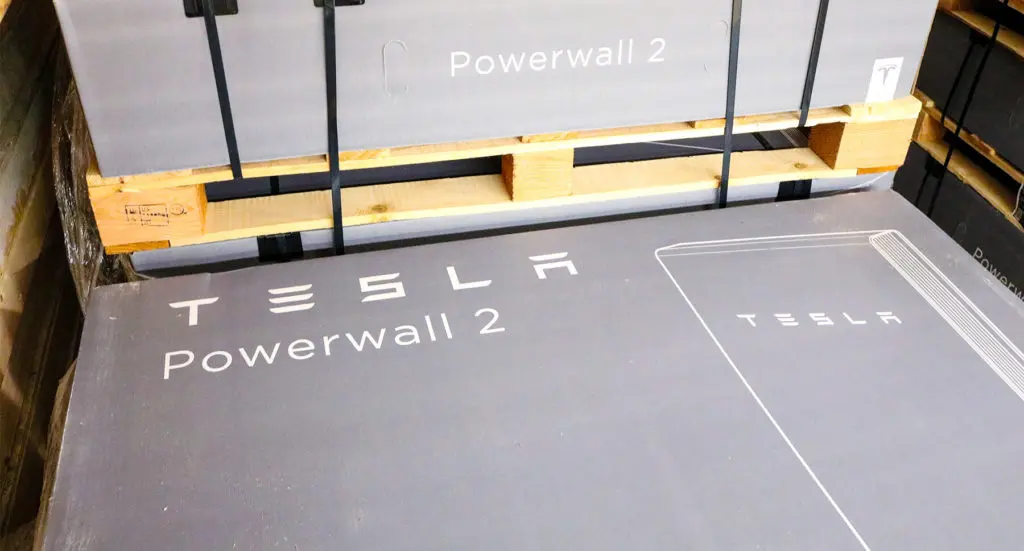
Are DIY Powerwalls safe?
After seeing the price of a Powerwall, you might be tempted to try a DIY Powerwall solution or find a DIY Powerwall kit online. We want to advise heavily against this option. Installing a Powerwall or other battery storage system involves the knowledge of a trained and experienced professional electrician and an electrical permit for your local jurisdiction.
Not only is it extremely dangerous to attempt this on your own, but you have to be a Certified Tesla Powerwall Installer to purchase and install Powerwalls. If you do find a Powerwall unit in a sketchy corner of the internet, it won’t come with a warranty unless it’s purchased and installed by a Certified Installer. But if you’ve got your mind set on a DIY Powerwall, please make sure you get one of those “In Case of Fire, Save Pets Inside” stickers for your door.
What type of warranty does a Powerwall have?
The standard Tesla Powerwall warranty is 10 years at 70% capacity. This means, if the Powerwall loses more than 30% of its storage capacity within 10 years it would be covered by the warranty.

When will the Powerwall 3 be available?
We get a ton of questions about the Powerwall 3 release date & Powerwall 3 specs. After much anticipation, Tesla recently announced that the Powerwall 3 will be available in 2024! Head over to this blog to learn everything we know so far, and if Powerwall 3 is worth the wait for you →
As a longstanding Certified Powerwall Installer, you can be sure that as soon as all the nitty gritty details of the Powerwall 3 are exposed, we’ll put it all right here. Until then, much like their vehicles, Tesla is improving the Powerwall 2 through over-the-air firmware updates to improve both the user interface and the functionality of the product.
Aside from firmware updates, Tesla has also made a slight hardware adjustment to one component of the Powerwall 2 system in the last couple of years — the Powerwall Gateway, which provides energy management and monitoring has evolved into the Gateway 2. The most noticeable difference is the upgrade in appearance from a grey block (think breaker box) to a sleek new look that mirrors the Powerwall 2 design, complete with Tesla branding! While everything still functions the same for homeowners, the Gateway 2 provides more options for setting up critical loads during install with circuits integrated directly into the Gateway 2 box.
Tesla Powerwall 2 Customer Review
While the Powerwall isn’t always the right solution for everyone, for some it’s a great benefit and key to maximizing solar savings — like for those whose utility does not offer net metering. Check out how home solar + Powerwall storage is working for one of our awesome Shine Tribe members in his review!
One of the tangential benefits of the Powerwall is the visibility (thru Tesla for instantaneous, and SolarEdge for longitudinal) to electricity consumption, and learning how to manage your aggregate consumption to solar + Powerwall capacity…
For example:
- In the morning, wait on showers until the Powerwall+solar has enough capacity to run the water heater (5kW)
- Set the electric car charger to run at a lower rate, unless we really need fast charging (we run at 2.8kW vs. 7.2kW max rate for the car and 10kW rate for the JuiceBox)
- Run the car charger for 3-4 hours during midday so that we don’t hit the grid. We still can easily put in 10 kW a day (40 miles or so) keeping it on the solar. We use the car to soak up “extra” power that we generate by keeping it less than full unless we need a full charge for a long trip.
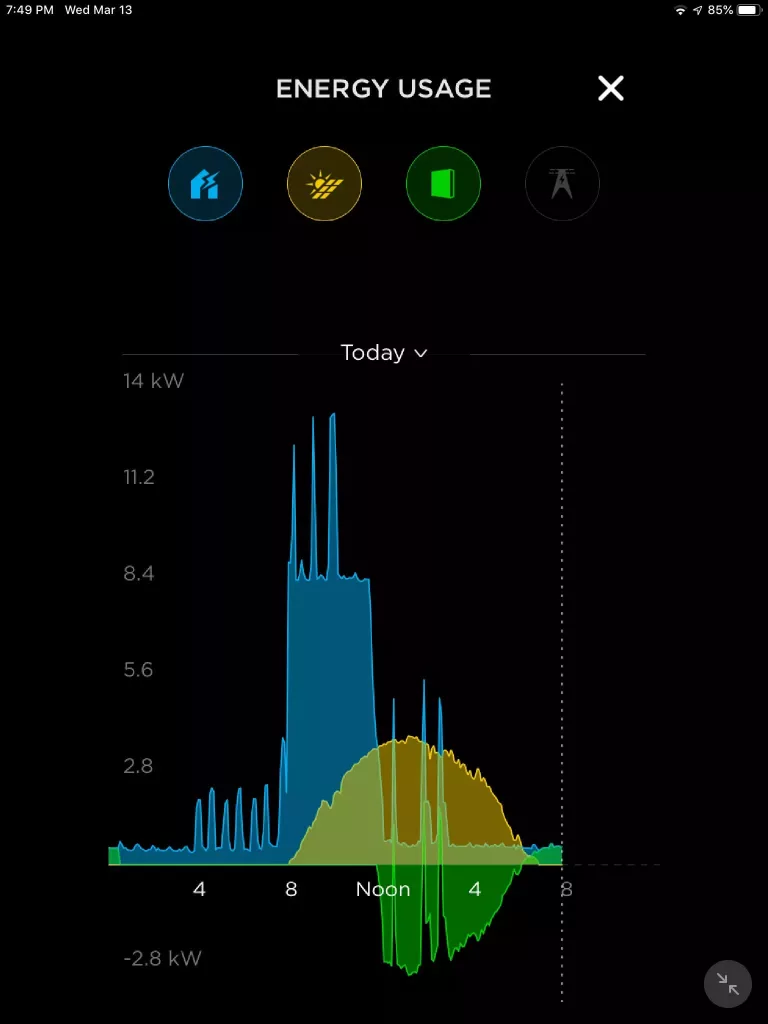
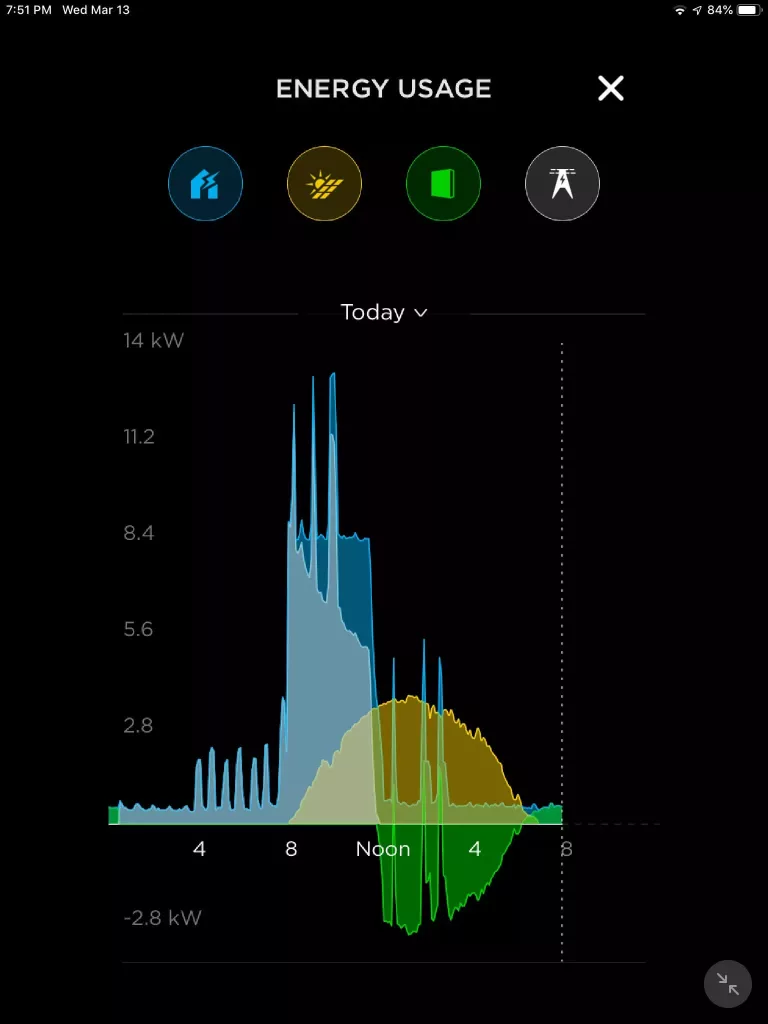
The first picture has home demand, solar, and Powerwall, with the second adding the grid overlay.
You’ll see that yesterday’s sunshine lasted until about 12:30am. Then, the HVACs cycled a bit between 4am and 8am. Then, I charged the car (the 7.2 kW plateau) for about 30 kWh; we were leaving to come to the Triangle at 12:30pm the car was half charged. I usually step down the charge rate to match solar but that wasn’t possible today. When I unplugged the car, the solar (we generated over 26 kWh today) started charging the Powerwall. The spikes in the early afternoon were the dishwasher.
The Powerwall went up to 85% today, and I currently keep a backup reserve of 10%. The Powerwall is currently at 80% and will run all night. If I didn’t have the Powerwall, I’d have given up a lot of power today, and if I hadn’t changed the car as I did, I would have filled the Powerwall and gone into uncompensated export.
So a real key is not only the system, but learning how to maximize the system. And we’re also continuing to do things to reduce the power footprint of appliances. We installed new heat pumps in October, so it will be interesting to see how they do during this upcoming cooling season. Already, during the heating season, it seems to be making a difference. We are shopping for one of the combo washer/condenser dryers to replace the traditional washer/dryer.
One of my favorite examples about power is one that I may have mentioned to you before. We have a set of bistro lights on the deck. When we bought them they came with 24 11 watt incandescent bulbs. We ran it 6 hours per day in the evening. so that was 264 watts, or 1,584 (1.5 kWh) per day. I noticed the spike on the Tesla app. Swapping to 2 watt LED cut that to 48 watts, or 288 watts per day, a reduction of 1.3 kWh per day or 473 kWh per year. That’s enough power to drive the electric car 1,900 miles…just for a set of bistro lights converting to LED from incandescent. And, the power reduction at $.10/kWh paid for the bulbs in less than a year…
So it’s working very well, and the Powerwall is a critical part of maximizing the benefit of going solar.
— Joel, SEM Shine Tribe Member
What's Next?
As we all know, Tesla’s products are in high demand. Get in touch today so we can answer any questions you may still have and start the process to make your Tesla Powerwall reservation.
Your Guide to Generac PWRcell
Ready to Get Started?
Schedule a free assessment to learn more about solar power & battery storage for your home.
About Us
North Carolina’s solar power and building performance expert. Founded in 2001, we’ve worked for 20+ years to improve the way people make and use energy.
© 2023 Southern Energy Management, Inc.

